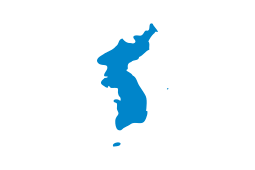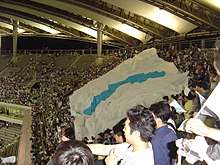Korean Unification Flag
 | |
| Proportion | 2:3 |
|---|---|
| Adopted | 1991 |
| Design | Image of the Korean Peninsula in solid blue, including the contested Liancourt Rocks, on a white field. |
| Korean Unification Flag | |
| Hangul | 통일기, 한반도기 |
|---|---|
| Hanja | 統一旗, 韓半島旗 |
| Revised Romanization | Tong(-)ilgi or Hanbandogi |
| McCune–Reischauer | T'ong'ilgi or Hanbandogi |
The Korean Unification Flag is a flag designed to represent all of Korea when North and South Korea participate as one team in sporting events.
Design
The background is white. In the center there is a blue silhouette of the Korean peninsula, including Jeju Island to the southwest, and Ulleungdo and the Liancourt Rocks to the east, added in 2003.
In the 2018 Winter Olympics, Ulleungdo and the Liancourt Rocks were not included in the flag.[1][2][3]
Variations
.svg.png) Korean Peninsula and Jeju Island
Korean Peninsula and Jeju Island Korean Peninsula, Jeju Island, and Ulleungdo
Korean Peninsula, Jeju Island, and Ulleungdo.png) Korean Peninsula, Jeju Island, Ulleungdo, and the Liancourt Rocks
Korean Peninsula, Jeju Island, Ulleungdo, and the Liancourt Rocks
Usage history
Sport

There was a plan for North and South Korea to compete as one team at the 1990 Asian Games although such efforts could not be realized. Ahead of the 1990 continental meet, the Korean Unification flag was conceived which features a silhouette of the Korean Peninsula including Jeju Island on a plain white field.[4]
The flag was first used in 1991 when the two countries competed as a single team in the 41st World Table Tennis Championships in Chiba, Japan[4] and the 8th World Youth Football Championship in Lisbon, Portugal.
The two countries' teams marched together under the flag in the opening ceremonies of the 2000 Summer Olympics in Sydney, Australia; the 2002 Asian Games in Busan, South Korea; the 2003 Summer Universiade in Daegu, South Korea;[5] the 2004 Summer Olympics in Athens, Greece; the 2006 Winter Olympics in Turin, Italy; the 2006 Asian Games in Doha, Qatar; and the 2018 Winter Olympics in PyeongChang, South Korea. However, the two countries competed separately in sporting events.
The flag was not used in the 2008 Summer Olympics in Beijing, China. Not only was a unified team shelved, but the Beijing Organizing Committee for the Olympic Games (BOCOG)'s plan to make the two Korean teams enter consecutively during the opening ceremony was rejected due to opposition by the North Korean delegation at the last moment.[6]
At the 2018 Winter Olympics in Pyeongchang County, South Korea, the two countries agreed to march together during the opening ceremony, and also competed together in women's hockey. The countries attempted to negotiate a similar arrangement for the Paralympics, but negotiations were stalled by North Korean officials requesting that the Liancourt Rocks be included on the flag.[7]
| Event | Location | Jeju Island | Ulleungdo | Liancourt Rocks | Ref |
|---|---|---|---|---|---|
| 1990 Asian Games | Beijing, China | [1] | |||
| 1991 World Table Tennis Championships | Chiba, Japan | [1] | |||
| 1991 FIFA World Youth Championship | Portugal | [1] | |||
| 2000 Summer Olympics | Sydney, Australia | ||||
| 2002 Asian Games | Busan, South Korea | [1] | |||
| 2003 Asian Winter Games | Aomori, Japan | [1] | |||
| 2004 Summer Olympics | Athens, Greece | ||||
| 2006 Winter Olympics | Turin, Italy | ||||
| 2006 Asian Games | Doha, Qatar | ||||
| 2018 Winter Olympics | Pyeongchang, South Korea | [1][2][3] | |||
| 2018 Asian Games | Jakarta and Palembang, Indonesia | [8] | |||
| 2018 Asian Para Games | Jakarta, Indonesia | [9] | |||
| 2018 Summer Youth Olympics | Buenos Aires, Argentina | ||||
| 2019 World Men's Handball Championship | Germany and Denmark | [10] | |||
| 2020 Summer Olympics | Tokyo, Japan |
Other contexts

Other occasions on which the flag were used include the following:
- The flag was prominently displayed at the border between the two sides when South Korean president, Roh Moo-hyun, walked into North Korea on an official visit in 2007.[11]
- In 2010, a large group of North Korean citizens and officials waved the flag when saying goodbye to South Korean Reverend Han Sang-ryol returning to South Korea from North Korea by crossing the DMZ line, but he was immediately arrested upon his return to South Korea.[12][13]
- In 2012, a large group of North Korean citizens and officials waved the flag when saying goodbye to Ro Su-hui, vice-chairman of the Reunification of the Fatherland Union (Pomminryon).[14] This was on the occasion of his return to South Korea from North Korea by crossing the DMZ line. Media reports referred to the flag as the “Korea is one” flag.[15] He was immediately arrested upon his return to South Korea (the moment he stepped over the border mark of the two Koreas) and later jailed.[16]
Symbolism
According to scholar and Korea expert Brian Reynolds Myers, South and North Koreans view the flag in different contexts. South Koreans see the flag as representing a peaceful relationship and coexistence with North Korea, whereas North Koreans view its usage by South Koreans as representing a desire to have their country annexed into North Korea. In this sense, Myers says, South Korean usage of the flag is more detrimental to their country's status vis-a-vis North Korea than North Koreans' usage of it in regards to South Korea.[17]
See also
References
- 1 2 3 4 5 6 7 "한반도기, 화합과 평화의 상징 맞나?" [Is the Korean Peninsula flag the harmony and the symbol of peace?]. BBC. 23 January 2018.
- 1 2 "Olympic Korean Peninsula Declaration" (PDF). International Olympic Committee. 20 January 2018.
- 1 2 "Annex B: Korean Unification Flag" (PDF). International Olympic Committee. 20 January 2018.
- 1 2 Jo, Hailey (19 January 2018). "A history of the unified flag the two Koreas will march under at the Winter Olympics". Quartz. Retrieved 25 January 2018.
- ↑ "2015 SU Update: Both Koreas Marching Together Again after 2003 SU?". FISU.net. Retrieved 17 June 2016.
- ↑ Mangan, J. A.; Hong, Fan (18 October 2013). "Post-Beijing 2008: Geopolitics, Sport and the Pacific Rim". Routledge. Retrieved 18 January 2018 – via Google Books.
- ↑ "'Flag dispute' halts joint Korean march". BBC News. 2018-03-08. Retrieved 2018-03-10.
- ↑ "아시안게임서 독도 들어간 한반도기 사용 어려울 듯" [Asian Games will not be able to use Korean Peninsula with Dokdo]. 7 August 2018.
- ↑ "Indonesia 2018: North and South Korea to march together".
- ↑ "Unified Korea to play at GER/DEN 2019". IHF. 2018-10-02. Archived from the original on 2018-10-03. Retrieved 2018-10-03.
- ↑ TheUnitedCorea (1 October 2007). "S-Korea President Roh Moo-hyun enters North". Retrieved 18 January 2018 – via YouTube.
- ↑ stimmekoreas (17 October 2010). "South Korean Pastor in North Korea / Südkoreanischer Pastor in Nordkorea". Retrieved 18 January 2018 – via YouTube.
- ↑ "South Korea pastor arrested on return from North visit". BBC. 20 August 2010. Retrieved 13 August 2014.
- ↑ stimmekoreas (5 July 2012). "S. Korean activist crosses Border in Panmunjom! - Ro Su Hui". Retrieved 18 January 2018 – via YouTube.
- ↑ Watson, Paul (19 July 2012). "South Korea good, North Korea bad? Not a very useful outlook - Paul Watson". the Guardian. Retrieved 18 January 2018.
- ↑ "International Committee for the Release of Mr Ro Su Hu". Retrieved 18 January 2018.
- ↑ Myers, Brian Reynolds (7 February 2018). "On the February 8 Parade and the Olympics". Sthele Press. Retrieved 9 February 2018.
By forbearing to march behind the yin-yang flag at the opening ceremony of the Olympics, the South Korean athletes are making a bigger sacrifice than the North Koreans... [T]he peninsula flag means two very different things to the two Koreas. In the South it symbolizes a desire for peaceful co-existence, or at most for a unification of equal partners in the reassuringly remote future. In wall posters above the DMZ it has always symbolized the southern masses’ yearning for “autonomous unification,” meaning absorption by the North. It’s worrying to think how inner-track propaganda is certain to misrepresent the South Koreans’ eschewal of their state flag for this of all symbols — and at this of all events.
External links
| Wikimedia Commons has media related to Korean Unification Flag. |
- North & South Korea, Sydney 2000 (page on non-national Olympic flags)
- Relationship between South and North Korea in 1990s
- Explanation and detailed design of the Korean Unification Flag (in Japanese)
- North, South Agree to Add Dokdo to the Korean Unification Flag (in Korean)
- Korean Unification Studies